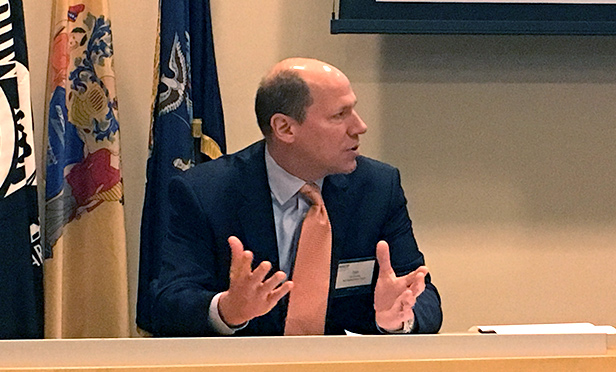 Tom Connery, president of New England Motor Freight, at NAIOP NJ Panel in Elizabeth, NJ (Steve Lubetkin photo/StateBroadcastNews.com. Used by permission.)
Tom Connery, president of New England Motor Freight, at NAIOP NJ Panel in Elizabeth, NJ (Steve Lubetkin photo/StateBroadcastNews.com. Used by permission.)
ELIZABETH, NJ—The velocity of change in the distribution and logistics sector is driving rapid technological change in transportation infrastructure, say panelists at NAIOP New Jersey’s Transportation and Logistics Update, held at the New York Shipping Association here.
Heated demand for industrial space means that the 800 million square feet of industrial space in the northern New Jersey market are being stretched thin, according to Anne Strauss-Weider, director of freight planning for the North Jersey Transportation Planning Association, who moderated a panel of experts.
 Anne Strauss-Wieder, director of freight planning of the North Jersey Transportation Planning Association
Anne Strauss-Wieder, director of freight planning of the North Jersey Transportation Planning Association
“What I’m hearing is that signing lease rates are actually above asking lease rates,” she says. “There is a near zero percent availability, not only here in New Jersey but also out to the Lehigh Valley. It is a hopping market.”
David Lambert, assistant commissioner of capital program management, NJ Department of Transportation, reviewed a number of state construction projects aimed at improving the flow of goods to the port and distribution centers in the northern New Jersey region. Among these is a $130 million project to improve port access from Routes 1 and 9 and Interstate 278; the Tremley Point connector road, a $150 million project to provide access to planned warehouses being developed in brownfield sites near Linden, NJ; and the $1 billion project to overhaul the Pulaski Skyway, which carries Routes 1 and 9 into Jersey City for access to the Holland Tunnel.
The Port of New York and New Jersey is the largest port on the east coast, with some 6.4 million TEUs (twenty-foot equivalent units, a standard cargo measurement) handled in 2015, Strauss-Weider says.
Because of the size of the consumer market in the New York-New Jersey metroplex, shippers of all kinds of retail goods are demanding proximity to the market for their distribution hubs, placing significant strain on the transportation infrastructure serving the area.
“Companies like Amazon try to get closer to the population centers,” says Thomas Connery, president of New England Motor Freight. “We’re seeing our length of haul actually being reduced because there are so many DCs (distribution centers) popping up for various online companies. It’s definitely impacted our business.”
Development of industrial property in the Lehigh Valley is very strong, Connery says, with a number of million-square foot projects in the Breiningsville, PA area.
Fulfillment centers for e-commerce retailers generally employ about three times the number of workers as a traditional warehouse property, says Strauss-Weider, adding that this requires different designs for these projects, including additional parking to accommodate the workforce. Fulfillment center operators, like Amazon, have in some cases needed to work with local transit agencies to enhance public transit options serving the facilities, so that workers can get to the sites.
Concerns about a truck driver shortage have not materialized, Connery says. “With GDP growth at two or 2-1/2 percent, we haven’t had a problem getting drivers, but I think if you go back to four percent GDP growth, it’s going to be a whole different story,” he says.
The port will benefit somewhat from the increased vessel size permitted through the upgraded Panama Canal, but changes in the economics of manufacturing will have an even bigger impact, says Bethann Rooney, assistant director of port performance initiatives, Port Authority of NY/NJ. Because a significant amount of manufacturing previously done in Southeast Asia is now moving to the Indian subcontinent, an all-water route to the Port of New York and New Jersey through the Suez Canal “is the more timely and cost-effective option” to many shippers, she says.
Once the Bayonne Bridge rehabilitation and raising is completed, the Port will be able to handle vessels up to 18,000 TEUs in size, she says. Eventually, shippers will reduce the number of ports at which they call, and focus their large vessels on the largest ports, giving the New York/New Jersey harbor an advantage.
“Smaller ports are likely to become niche market ports, and be served by us, probably by barge, and more by rail,” she says.

















 Copyright © 2024 ALM Global, LLC. All Rights Reserved.
Copyright © 2024 ALM Global, LLC. All Rights Reserved.